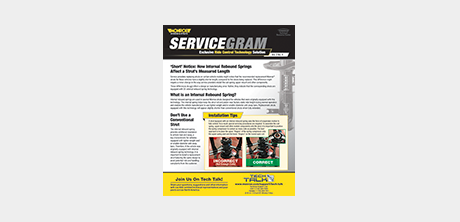ServiceGram Vol. 3, No. 1
How to Know if Coil Springs Are Worn
Challenge:
Looking Beyond Static Ride Height When Diagnosing Bad Coil Springs
Maintaining proper ride height is crucial to vehicle durability, performance and safety. When ground clearance is too low, drivers may experience excessive tire wear and severe damage to suspension components. Furthermore, improper ride height can impact vehicle alignment, directional stability, stopping distance and steering control.
When performing inspections, automotive service professionals often are looking for issues with static ride height, or the ride height of a vehicle at rest. Measuring ride height in this manner might suggest adequate ground clearance, but “dynamic” ride height – the ride height of a vehicle in motion – may tell a different story. With today’s lighter vehicles and suspension components, a vehicle with acceptable static ride height may still bottom out while moving, or during loaded conditions. The cause of such dynamic ride height issues is often worn or damaged coil springs. Automotive service shops performing strut replacements sometimes try to save their customers money by retaining the old coil springs, but the reality is that this could cost the consumer more.
Solution:
Complete Diagnosis
Automotive service professionals should avoid relying only on static ride height measurements to determine spring condition. A more thorough inspection focusing on several key indicators of worn springs can help avoid this pitfall.
Complete Replacement
Ultimately, the best way to ensure proper ride height and ground clearance at static resting height and during operation on the road is to always replace the complete strut assembly, springs included. Doing so likely will save customers money in the long run. When installing new springs, technicians should be sure to grab as many coils as possible during installation to prevent damage. Alternatively, by installing Monroe Quick-Strut® complete strut replacement assemblies, technicians can quickly and easily restore a vehicle’s factory ride height without having to compress the coil spring or use specialized tools.

Warning Signs of Worn Springs
- Worn, smashed or missing jounce bumpers
- Marks on the suspension stop where jounce bumper impacts
- Excessive tire wear
- Compromised handling or ride quality
- Rust or corrosion on the springs
- Inconsistent spring ramp angles or kinks
- Excessive sagging, leaning or swaying (especially when loaded)
Learn more about quality suspension parts, find the right car part, or find a local repair shop today.
The content contained in this article is for informational purposes only and should not be used in lieu of seeking professional advice from a certified technician or mechanic. We encourage you to consult with a certified technician or mechanic if you have specific questions or concerns relating to any of the topics covered herein. Under no circumstances will we be liable for any loss or damage caused by your reliance on any content.


